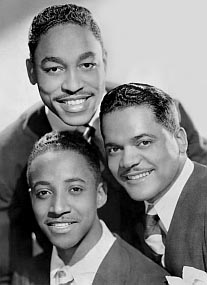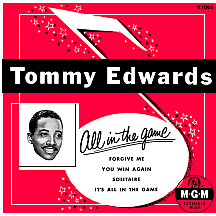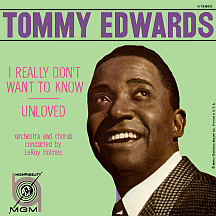TOMMY EDWARDS
Many entertainers are familiar with the high peaks and low valleys encountered during a show business career. Singer and songwriter Thomas Jefferson Edwards, Jr. became well acquainted with the difficulties of maintaining success, or simply trying to earn a living, over a career lasting a quarter of a century. His peak, and it was a high one, came nearly 20 years after his first break at the age of 17; "It's All in the Game," its melody composed ten years before his birth, placed him on the charts twice, in two different versions, the latter becoming one of the best selling singles of the late 1950s.
Henrico, Virginia, located on the northwest edge of Richmond, was his place of birth in October 1922. He grew up near Pemberton Elementary School, but because of the segregation laws in effect at the time attended the nearby Quioccasin School with other African-American children. Young Tommy's parents, Thomas and Buena Vista Edwards, recognized his singing talent when he was just a few years old and encouraged him to learn to play piano. The family attended Quioccasin Baptist Church, where he was given the opportunity to sing and develop his skills. Other family members were musically-oriented as well; brother Nathan Edwards played trumpet and sister Harriet developed a fine singing voice. In 1939, at about the time he turned 17, The Tommy Edwards Show began a one-year run on WRNL radio 910; he sang popular songs, played piano and was often joined by his talented siblings.
In 1943, at age 21, Tommy moved to New York (Harriet also made the trek a couple of years later, just after the end of World War II). He frequented Small's Paradise, an integrated nightclub in Harlem that was very popular, and sometimes performed with the bands there while writing and recording demos of his songs to shop around to music publishers. He had a knack for creating lyrically clever, uptempo numbers; one that he'd written with Chicago-based bandleader and record producer Jimmy Hilliard, the double-entendre "That Chick's Too Young to Fry," became a hit for Louis Jordan in the fall of 1946 and was performed by Jordan the following year in the musical film Reet, Petite, and Gone.
Edwards, a fan of The King Cole Trio, put together a carbon copy act with guitarist Hilton Brooks and bass player Lucky Criss backing him as vocalist and pianist. The Tommy Edwards Trio first recorded for the small Top label in 1947 and '48; the smooth Cole style was tempered with whimsical Jordan-leaning offerings like "The Cherry in My Fruit Cocktail" and an Edwards original, "You Got To Straighten It Out." The larger National Records picked up the band's contract and released three singles in 1949 including Tommy's composition "(Meow-Meow) Up In The Alley," a novelty vocal (identified as such on the label) and a romantic original, "Just Love, My Sweet."
When none of these became hits, the trio broke up and Tommy entered the new decade where he'd left off a few years earlier, hawking his original songs to various music publishers and record labels; Tony Bennett recorded "One Lie Leads to Another" and country and western star Red Foley resembled a jump blues singer like never before on "Paging Mister Jackson." Late in the year, Tommy auditioned for MGM Records, hoping they would be interested in him as a songwriter. Instead, label execs were impressed by his singing voice and signed him on that basis. "Once There Lived a Fool," a sentimental ballad delivered more softly than anything he'd previously done, became Tommy's first MGM single in early 1951. He landed a top 30 hit with his fourth release, "The Morningside of the Mountain" (where 'she' lived while 'he' lived on '...the twilight side of the hill'), a Dick Manning-Larry Stock song that would figure into a later phase of Edwards' career.
It was the next song, though, that ultimately defined him as an artist. "It's All in the Game" began as an instrumental, "Melody in A Major," written in 1912 by Ohio-born Charles Gates Dawes, a lawyer and later a banker with a side interest: composing music and playing flute. He was an Army General during the Great World War, winner of the Nobel Peace Prize in 1925 and served as U.S. Vice President from '25 through '29 under Calvin Coolidge. "Melody in A Major" was often played when Dawes appeared in public during the 1920s, a "theme song" of sorts for the nation's V.P. In 1951, New Yorker Carl Sigman, a prolific composer and lyricist, added ultra-romantic lyrics to the instrumental tune: 'Once in a while he won't call, but it's all in the game...soon he'll be there at your side with a sweet bouquet...and he'll kiss your lips, and caress your waiting fingertips...and your hearts will fly away.' While several popular artists recorded the song that year (Dinah Shore and Sammy Kaye among them), Tommy Edwards had the biggest version, reaching the top 20 in September. The disc's flip, "All Over Now," was an original by Tommy that became the more popular side in the R&B field, going top ten on that chart in November '51.

Variety called him "a new singing star," but had perhaps jumped the gun on its evaluation. Two songs were minor hits in '52: "Please, Mr. Sun" (penned by Ramon Getzov and Sid Frank) struggled to compete with Johnnie Ray's top ten version and a cover of Hank Williams' "You Win Again" made a brief chart appearance. Tommy had one failure after another over the course of more than a dozen single releases, despite high production values and some excellent vocal performances. He was still signed to MGM in 1958 but hadn't done any studio recordings since the fall of 1955. The dual-channel stereo craze was happening at the time and MGM executive Morty Craft figured "It's All in the Game" would sound great using the current technology. Tommy, who'd become so desperate he was borrowing money from anyone who would part with a ten dollar bill ("When it's five years between hits, you can get awful broke," he once said), welcomed the opportunity.
Harry Myerson produced the new version at New York City's Metropolitan Studio in June of '58, using a "beat-ballad" approach common in the rock and roll and romantic teen records of the day; Tommy's voice, filled with hopeful longing, pushed all the right buttons. MGM released it immediately and the timing couldn't have been better: the record spent six weeks at number one that fall, ranking it right up there with the biggest hits of Elvis Presley, the era's biggest star (Charles G. Dawes remains the only U.S. Vice President to have co-written a number one hit single). In October, Tommy performed the song on NBC-TV's Your Hit Parade, and it was actually publicized that he was "...the first negro to be featured on the popular show in its 17-year history." During the broadcast, he was presented with a gold record for "It's All in the Game," which went on to sell more than three million copies (helped in part by the B side, "Please Love Me Forever," which made the charts separately). Dick Clark of American Bandstand accurately referred to Tommy's hit as the "comeback of the year."
In December, "Love is All We Need" (penned by Ben Raleigh and Don Wolf) joined its predecessor in the top 20. Leroy Holmes was the orchestra leader and arranger on these and continued in that capacity for the next few years. Earlier hits "Please Mr. Sun" and "The Morning Side of the Mountain" (slightly altered titles) were remade in the newer style and both were hits. Reaching back again to 1912, the Ernie Burnett-George A. Norton classic "My Melancholy Baby" became Tommy's fifth top 30 hit in less than a year. Several of his original songs (including "Mr. Music Man" and "I Looked at Heaven") landed on flip sides and some vintage oldies were updated (Cole Porter and Robert Fletcher's "Don't Fence Me In" went top 50 in early 1960).
"I Really Don't Want to Know," a Howard Barnes-Don Robertson song that had been a country hit for Eddy Arnold in 1954, sent Edwards to the top 20 one last time in July 1960; his final chart single came in October with country whisperer Bill Anderson's "It's Not the End of Everything." His interest in country music resulted in Tommy Edwards Sings Golden Country Hits, a 1961 album featuring renditions of many 1950s C&W standards like Hank Williams' "I'm So Lonesome I Could Cry." But the timing apparently wasn't quite right; Ray Charles, a longtime country fan who'd previously recorded in the genre, took the concept to much greater heights the following year with his multi-million-selling Modern Sounds in Country and Western Music.
For Tommy, the down cycle of the mid-1950s repeated itself. He stayed with MGM through 1964, then recorded for Musicor (country star George Jones was a co-owner of the label) in '65 and '66. No recordings were made afterwards, but he supported himself performing in nightclubs in the U.S. and parts of Europe. His death in October 1969, at age 47, came as a shock to many close to him, while many people around the world, if they thought of him at all, placed him in the "What ever happened to?..." category. He'd developed a drinking habit; after returning home to Henrico County, the situation worsened. The cause of death was attributed to cirrhosis of the liver. Afterwards he was buried in an unmarked grave at Quioccasin Baptist Church, though eventually, through fundraising efforts, a gravestone was added that gave mention of his signature song. In addition, a historical marker celebrating his achievements was placed nearby on Pemberton Avenue.
"It's All in the Game," as recorded by Tommy Edwards the second time around, has earned its place among the greatest hits of all time. Hundreds of artists have performed and/or recorded the famous standard; it became a top 30 hit for two different artists in the years following its unusual twice-for-the-same-singer pattern. British superstar Cliff Richard scored with a quietly effective interpretation in 1963 and Motown's Four Tops updated the song further with a soulful 1970 hit version.
NOTABLE SINGLES:
- You Didn't Want Me When You Had Me - 1947
by Tommy Edwards Trio - The Cherry in My Fruit Cocktail - 1947
by Tommy Edwards Trio - You Got to Straighten it Out - 1947
by Tommy Edwards Trio - Sweet Emalina, My Gal - 1948
by Tommy Edwards Trio - (Meow-Meow) Up in the Alley - 1949
by Tommy Edwards Trio - It's Just Love, My Sweet - 1949
- Once There Lived a Fool - 1951
- The Morningside of the Mountain - 1951
- It's All in the Game /
All Over Again - 1951 - Christmas is For Children - 1951
- Please, Mr. Sun - 1952
- You Win Again - 1952
- Paging Mister Jackson - 1953
- The Joker (In the Card Game of Life) - 1954
- It's All in the Game /
Please Love Me Forever - 1958 - Love is All We Need /
Mr. Music Man - 1958 - Please Mr. Sun /
The Morning Side of the Mountain - 1959 - My Melancholy Baby - 1959
- I've Been There /
I Looked at Heaven - 1959 - Honestly and Truly /
(New In) The Ways of Love - 1959 - Don't Fence Me In - 1960
- I Really Don't Want to Know - 1960
- It's Not the End of Everything - 1960
- Suzie Wong - 1960
- I'm So Lonesome I Could Cry - 1961
- Left-Over Dreams - 1964
- Take These Chains From My heart - 1965
- I Cried I Cried - 1966



